Texas Consumers Deserve Reliable Grid at Affordable Cost
Contact:
Sandie Haverlah – (512) 423-0913
Dr. Josh Rhodes – (512) 658-2965
An analysis of key energy legislation passed by lawmakers in 2023 finds that the current operating procedure does not meet widely accepted standards for grid reliability, but the Public Utility Commission of Texas (PUC) has several options available for improving reliability. As expected, all scenarios for attracting more electric generation will be at an increased cost.
The analysis was prepared by Josh Rhodes of IdeaSmiths and Rajaz Amitava of Astrapé Consulting for Texas Consumer Association (TCA). The researchers specifically analyzed key features in H.B. 1500 and S.B. 2627 that were intended to achieve reliability and the costs associated with implementation. This is the first independent analysis of these two important pieces of legislation.
The study shows that Texas consumers will pay at least $1 billion more annually if the PUC implements the Performance Credit Mechanism (PCM) method according to H.B 1500. But the grid will still be at risk of experiencing nearly a day of outages every year.
Conversely, the study also shows that changes to the implementation of the PCM will cost more but can significantly improve grid reliability equal to the historical standard of one day in a decade. To achieve this, changes in legislation would be required to remove the cap of $1 billion dollars on the PCM and allow for all generation sources to participate.
“TCA was never enthusiastic about PCM and opposed implementing it. But since ERCOT and the PUC continue the implementation process, we find it essential to look at the details of how it can achieve the best reliability at the lowest possible cost,” said Sandie Haverlah, TCA president. “This study makes it clear that the PCM cap, combined with limiting the generation sources that can participate, alters the program. As a result, the additional $1 billion expense fails to achieve the best possible grid reliability.”
Additionally, the study reveals that firming requirements do not achieve the level of reliability even when combined with the current PCM structure. Also, more firming capacity is needed in the winter than in the summer.
The Dispatchable Reliability Reserve Service (DRRS) as outlined in S.B. 2627 can meet the higher reliability standard, but only at a cost that similar to what is needed for the most effective PCM implementation.
Lastly, the Texas Energy Fund (TEF), which was on the ballot as Proposition 7 in 2023, by itself cannot achieve the higher reliability target. The TEF was initially funded with billions of taxpayer dollars to provide low-interest loans and incentives to build natural gas power plants.
TCA believes that any reliability program implemented, including PCM or DRRS, should accomplish three simple objectives:
Improve reliability to a grid event to a historical industry standard of .1 or one day per decade or less;
Ensure Texans get the most grid reliability bang for the buck by improving reliability and minimizing costs;
Meet the reliability goals repeatedly stated by lawmakers.
“Texas consumers will pay tens of billions of dollars over several decades for the long-term reliability failures during Winter Storm Uri,” said Haverlah. “Taxpayers are fronting another $5 billion for a loan program this study shows can’t deliver the grid reliability we should expect. It’s our hope that lawmakers, regulators, and the grid operator will correct the course to provide Texas consumers the reliability they expect at a cost they can afford.”
###
Texas Consumer Association is a 501c(4) non-profit organization that has been representing individuals and small businesses on pocketbook issues for over 50 years. www.texasconsumer.org

